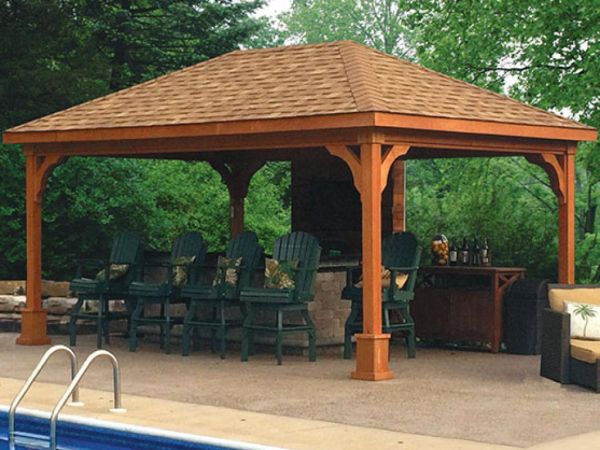Eight-Sided Pavilion Architecture Diagrams - How To Guarantee You Do It Right
Make sure the corners are square before fitting the braces into place. Generally, the holes will need to be drilled until they are approximately 12 inches deep. Maybe you'd like to plant annuals so you can change them each year according to your mood or you might prefer perennials that grow back each year and reduce maintenance. You can opt to have the screens as a permanent fixture of the gazebo. Cut a piece of wood so you create even gaps. If yours isn't, the roof can be handled in any of several ways. On a one-story house, it is often best to attach the ledger for a patio roof just below the house's eaves.
A hammer, nails and a saw would also be required. For most concrete slabs, a jackhammer (useful source) will then need to be used in order to break through the concrete, and form a hole. The tops of the posts need to be cut into a tenon to hold the secondary beams. Once we knew our base was level in its position, we then rested it on a makeshift work table. The two pairs of girders would support the weight of the pergola's rafters and purlins. In many instances, a certain pitch may be necessary or even required by local codes. You'll have four or five colors to choose from.
Similarly, scroll-work or cutouts, particularly four-leaf designs, were common to Victorian gazebos and can be easily replicated in modern summerhouse design. Another plus is an optional awning cover that'll let you nap even during a gentle summer rain. Your location would determine whether you dig holes for the columns or secure your supports using base anchors. A framing square is traditionally used for laying out the roof and determining pitch. This was done to prevent the ends of the 2nd double set of headers above it from warping. The top of each column has a 30 degree slope. This is where the flush trim router bit comes in real handy when smoothing the bottoms of the notches.
These hurricane clips are the way to do that. On prepared ground, add a 25mm thick sand bed. The solution was in a neglected corner of their backyard-the perfect spot for an outdoor living room based on a simple platform deck. The roofing material, as well as the girders and headers, all need to be sized to carry whatever snow load is expected for your area. Before you start building or buy any materials, check with your local building department for local code, permits, and inspection information. Cut off the top of the columns where you have marked, with a circular saw.
A skid-steer loader will rut your lawn, so plan on filling in the path with topsoil and grass seed when you're done. Lay down the next circle of planks and fasten them with screws. After you have chosen what your base is gonna be made of, it's time to scout a flat surface that you will lay your foundation on. Mount the doors with four butt hinges, and install latches and handles, and if desired, pneumatic door closers. This turns a flimsy frame into a super-strong one. Mark a level or board with the total step run calculated. Anything out of line would be especially noticeable where the front wall of the house sits on the deck.
A pavilion creates an instant focal point in a yard, offering a place to get out of the sunlight and enjoy the beauty of a garden. You'll have some extra because the wall steps down on the ends, but you might need it if any of the blocks are damaged. Cut along the outline with a circular saw until you reach the inner portion of each step outline. Pull side strap to post, mark bracket location. Your pergola will be large enough to hold a dining table, but the same plan with narrower dimensions could be used to create a smaller pergola.
